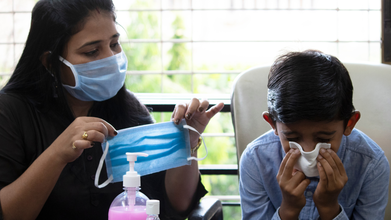- Health Conditions A-Z
- Health & Wellness
- Nutrition
- Fitness
- Health News
- Ayurveda
- Videos
- Medicine A-Z
- Parenting
Micronutrient Deficiencies Could Mimic Learning Disorders In Kids, Parents Here’s What You Can Undo

Credits: Canva
If your child is having trouble paying attention in class, remembering instructions, or showing signs of poor academic performance, it's natural to wonder about a learning disorder. But suppose the real culprit is hiding in their lunchbox?
A shocking body of research now suggests that micronutrient deficiencies among children can hauntingly mimic the symptoms of cognitive delay, behavioral issues, and even learning disabilities. What may seem to be a developmental or neurological disorder may well be traced back to a far more preventable source: a lack of vital vitamins and minerals.
Hunger is not just about empty stomachs—it's about the lack of quality nutrients the body needs to function and grow. In the United States alone, more than 13 million children—about 18%—live in food-insecure households. That means almost one in five children who don't have regular access to nutritious meals.
In accordance with a number of studies, children who develop in food-insecure homes are likely to enter school behind. They are less likely to be developmentally prepared for kindergarten, and are likely to suffer from undiagnosed iron deficiency anemia—an problem research has determined to weaken memory and social functioning even a decade later.
Their performance at school declines with lower test scores on standardized tests, slower reading development, and more emotional and behavioral problems. The majority of these children receive inappropriate diagnoses of learning disabilities when, in fact, they are struggling due to nutrient deficiencies.
It's easy to get confused between the symptoms of micronutrient deficiency and learning or attention disorders. Children can appear sluggish, daydreamy, irritable, or lack interest in learning—symptoms most typically associated with ADHD, anxiety, or developmental delay.
A learning disorder is where the brain perceives information in a different manner, which holds a child back from learning or applying certain abilities effectively—yet they might be of average or above-average intelligence. This neurologic condition creates a noticeable deficit between the potential and existing academic performance of a child. Learning-disabled children may experience trouble with reading, writing, math, or attention, but the point is that these troubles are not linked with intelligence or effort. Early recognition and intervention are the most effective means of allowing children to acquire the skills required to be successful in school as well as everyday life.
But as Nutritionist Aman Puri says, it begins in the kitchen, "Good nutrition is the foundation for a child to grow and develop to his/her full potential. While motor and cognitive function begin unfolding during early childhood, deprivation of essential nutrients delays or impedes these natural milestones."
In particular, iron, zinc, iodine, and vitamin B12 deficiencies have actually been specifically implicated in cognitive dysfunctions, trouble remembering things, and low IQ levels. Even in certain cases, these deficiencies aren't visibly apparent until a great deal further down the line—when the academic or behavioral issues suddenly begin surfacing.
How Each Nutrient Affects Your Child's Brain?
Iron is needed to deliver oxygen to the brain. Deficiencies reduce red blood cell production and hemoglobin, impacting cognitive development directly.
Zinc is linked with attention span, problem-solving, and memory consolidation. Deficiencies can slow learning significantly.
Iodine is needed for early brain development. Iodine-deficient children have lower intelligence test scores and are at risk for goitre.
Vitamin B12 supports neurological function. Deficiency can retard motor skills and mimic ADHD and language processing disorder symptoms.
"Deficiencies may or may not initially present with any symptoms at all," says Puri. "But over time, they may influence brain growth so much so that it becomes easy to equate them with clinical learning disability."
The Problem With Modern Diet is More Than Junk Food
Even in households where food is abundant, nutrition can be lacking. Between processed foods, fast food, and sugary drinks, children are taking in calories—but not necessarily the essential nutrients they require. Throw in hectic parental schedules and a lack of nutritional knowledge, and the outcome is a recipe for malnourishment, even in middle-income households.
Malnutrition is the cause of nearly half of the deaths of all children under age five, and the World Health Organization (WHO) tells us so. And to those few who survive it, developmental lags and learning issues become the normal challenge to deal with.
Simple Steps for Smarter Nutrition Parents Can Follow
So what can be done? First, parents can take back control by providing a well-balanced, micronutrient-dense diet. Puri recommends introducing fortified foods and natural sources of essential nutrients early on—namely, the first five years of life when the brain grows most rapidly.
Nutrients to include:
Iron: Leafy greens, legumes, eggs, lean meats
Zinc: In milk products, seeds, and whole grains
Iodine: From iodized salt, seaweed, and milk
Vitamin B12: Found in fish, eggs, milk, and fortified cereals
Folate, calcium, vitamins A, D, and E: Best found on a plate of rainbow hues
"Nutrition education strategies must begin with maternal and child health programs," says Puri. "Mothers must be educated on the long-term consequences of micronutrient deficiencies and the benefits of early dietary intervention."
Before rushing to label your child with a learning disorder, take a closer look at their plate. The brain, like any other organ, responds well to optimal fuel. And occasionally, the solution to deficient focus, mood swings, or learning lags is as elementary—and as life-changing—as an upgrade in nutritional quality.
Aman Puri is a Nutritionist and Founder, Steadfast Nutrition with an expertise as a Sleep Science Coach and in Sports Psychology.
Is There A Link Between Social Media Use And Increased ADHD-Like Symptoms In Kids?

Credits: Canva
Do you feel like your attention span has gone down? Thanks to multiple social media platforms and its shorter duration content, we find ourselves losing attention and cannot keep up with anything that goes a little bit over a minute. This has not just affected us, but children are now being diagnosed with attention deficit hyperactivity disorder (ADHD) more.
A latest peer-reviewed study by Karolinska Institutet, which monitored more than 8,300 US-based children from age of 10 to 14 noted that social media use has lead to increased inattention symptoms.
The researchers of the aforementioned institute in Sweden, along with the Oregon Health & Science University in the US found that children spent an average of 2.3 hours a day watching television or online videos, 1.4 hours on social media and 1.5 hours playing video games.
The study found no connection between ADHD-related behaviors, such as distractibility, and activities like playing video games or watching TV and YouTube. However, long-term social media use was linked to rising inattention symptoms in children. ADHD is a neurodevelopmental condition marked by impulsiveness, trouble focusing and frequently forgetting everyday tasks.
. According to the researchers, “We identified an association between social media use and increased inattention symptoms, interpreted here as a likely causal effect.” They noted that while the impact on each child may be small, widespread behavioral shifts could have a meaningful effect at the population level. The study also suggested that growing social media use may be contributing to the rise in ADHD diagnoses.
Why Social Media May Disrupt Focus
Torkel Klingberg, a professor of cognitive neuroscience at the Karolinska Institute, said the findings pointed specifically to social media as a factor affecting children’s ability to concentrate. He explained that platforms bombard users with constant notifications and messages, and even the anticipation of receiving one can interrupt mental focus. “This affects the ability to stay focused and could explain the association,” he said.
The research also showed that socioeconomic background and genetic risk for ADHD did not change the observed link, suggesting that the distraction-rich environment of social media itself may be responsible. Klingberg added that increasing social media use could partly explain the rise in ADHD diagnoses among children, which grew from 9.5 percent in 2003–07 to 11.3 percent in 2020–22, based on data from the U.S. National Survey of Children’s Health.
Early Social Media Exposure Raises Concerns
The authors stressed that the study does not imply all children who use social media will develop concentration problems. However, they pointed out that many children begin using these platforms well before age 13, the minimum age for apps such as Instagram and TikTok. The report called for stronger age verification measures and clearer guidance from tech companies.
How Much Time Children Spend Online
The study tracked a gradual rise in social media use, from around 30 minutes a day at age nine to about two and a half hours by age 13. The children were enrolled at ages nine and ten between 2016 and 2018. The full findings will appear in the journal Pediatrics Open Science.
Samson Nivins, a postdoctoral researcher at the Karolinska Institute and one of the study’s authors, said the team hopes the results will help parents and policymakers make more informed decisions about healthy digital habits that support children’s cognitive development.
Why A Persistent Cough In Children Needs Attention, And Ways To Strengthen Their Immunity, According To Doctor

Credits: iStock
As winter settles in and children move between school, outdoor play, and indoor gatherings, coughs and colds often become unavoidable companions. While many coughs resolve on their own, doctors warn that a cough that lingers for weeks is not something parents should overlook. At the same time, the cold season naturally weakens a child’s defenses, making it important for families to follow simple steps to improve immunity.
When a Cough Lasts Too Long
According to Dr Nishant Bansal, Consultant Pediatrician and Neonatologist at Motherhood Hospitals, Noida, parents must stay alert when a cough stretches beyond the usual duration. He explains, “A cough that lasts for weeks should never be ignored. While many are caused by mild infections, persistent or recurring coughs can point to allergies, asthma, or an underlying health issue.”
Many children are catching respiratory infections during weather changes or after starting school. As temperatures drop, coughs tend to worsen. What may look like a harmless lingering cold could actually be linked to an allergy, asthma, sinusitis, whooping cough, or even exposure to pollutants and smoke.
Dr Bansal adds, “If a child’s cough becomes worse at night, during exercise, or after exposure to dust or pets, it may be triggered by asthma or allergies. These symptoms should be reported to a doctor without delay.” Children exposed to polluted air or cigarette smoke are especially prone to constant coughing and wheezing.
Ignoring these symptoms can interfere with sleep, appetite, growth, and energy levels. Some infections, such as whooping cough or sinusitis, require prompt treatment to prevent complications. That is why early identification of the cause is essential.
Managing and Preventing Persistent Coughs
Parents often try repeated home remedies such as honey, steam, or warm fluids, but these may not be enough. “If the cough lasts more than two to three weeks, it should be evaluated instead of being managed with only home remedies,” says Dr Bansal.
Indoor air quality plays a major role. Avoid smoking around children, improve ventilation, and use an air purifier if possible. Keeping children well hydrated with warm soups, milk, or water can soothe the throat and loosen mucus. Over the counter cough syrups should be avoided unless a doctor prescribes them.
Warning signs such as wheezing, breathing difficulty, coughing fits, or fever need immediate medical care. Timely guidance helps the child breathe better, recover faster, and avoid long term complications.
Why Winter Increases Illnesses in Children
Children are naturally more vulnerable during colder months. They often face sore throats, colds, coughs, and viral infections that spread easily when people gather indoors. Dr Atul Palwe, Consultant Pediatrician and Neonatologist at Motherhood Hospital, Lullanagar, Pune, explains, “Viruses spread more easily in winter, especially when children stay in closed spaces for long hours.”
Strengthening immunity is key to helping children stay healthy throughout the season.
Simple Ways to Boost a Child’s Immunity
Focus on a Nutritious Diet
“A strong immune system begins with a balanced diet,” says Dr Palwe. He recommends plenty of fruits, vegetables, whole grains, legumes, nuts, and seeds. Foods rich in vitamin C such as oranges, guavas, and amla, along with zinc and iron rich foods, help build resistance.
Maintain Hydration
Children tend to drink less water in winter, but staying hydrated helps the body remove toxins. Warm soups and milk are comforting alternatives.
Encourage Regular Activity
Indoor games, yoga, and outdoor play on pleasant days improve blood circulation and strengthen immunity.
Ensure Adequate Sleep
“Children under ten need about ten to twelve hours of sleep every night to keep their immunity strong,” says Dr Palwe.
Teach Hygiene Habits
Handwashing before meals, after play, and covering the mouth while coughing reduces the spread of infections.
Dress Them Warmly
Layering helps protect children from cold winds while still allowing movement.
Get Enough Vitamin D
Limited sunlight in winter can affect vitamin D levels. Dr Palwe suggests encouraging morning outdoor play or discussing supplements with a doctor if needed.
Older, Younger or Middle Child: Does Birth Order Shape Your Personality?

Credits: iStock
Are you a younger sibling in your family and you relate to other younger siblings? Do you feel some of your habits and traits match other younger siblings? Or are you the middle child and you feel that sometimes you are excluded. When you talk about it, other middle children also agree with you. If this is the case with you, then you may be interested to know the Birth Order Theory.
This theory was developed by Alfred Adler in 1964, who focused on the importance of birth order on personality development. In this theory, he says that though children may be born into the same household, their birth order greatly influence their psychological development.
As per Adler's birth order theory, a child could have certain personality traits which are as followed:
- The Oldest Child: more authoritarian, and feels powerful due to high expectations set by the parents
- The Youngest Child: treated like a spoiled baby and cannot rise above the other siblings
- The Middle Child: even tempered, but has trouble fitting in as they have always been sandwiched between the younger and the older siblings
However, for middle child, their characteristics would often get itself a term, called the Middle Child Syndrome.
What Exactly Is A Middle Child Syndrome And What Sets Them Apart From Their Younger And Older Siblings?
Middle child syndrome is the belief that middle children are excluded, ignored, and neglected because of their birth orders.
People often talk about “middle child syndrome,” the idea that the child who is neither the oldest nor the youngest develops a very particular personality. While some of this comes from family dynamics rather than science, many families do notice certain patterns.
Personality Traits
Middle children sometimes feel overshadowed by their siblings. The oldest is often seen as responsible and strong-willed, while the youngest gets extra attention for simply being the baby of the family. The middle child may end up somewhere in the middle of all this, which can make them quieter, more even tempered, and sometimes unsure of where they fit in.
Family Relationships
When it comes to parents, middle children might feel that they do not get the same level of attention as their siblings. The older child usually carries more responsibility, and the younger child often gets extra care and protection. The middle child may feel they slip through the cracks and receive less one-on-one time with their parents.
Sibling Rivalry
Feeling unseen can spark a sense of competition. Many middle children find themselves competing for attention from both parents and siblings. At the same time, they often become the peacemaker of the family simply because they are used to being in the middle of everything.
Feeling Left Out of Favoritism
When parents unintentionally favor the oldest for their achievements or the youngest for their sweetness, the middle child may feel they are no one’s first pick. They are not the trailblazer or the baby, and this can shape how they see their place in the family.
Carrying These Feelings Into Adulthood
Some people believe that these early experiences can follow middle children into adulthood. If a middle child grew up feeling overlooked, they might struggle with co dependency or constantly try to keep the peace in relationships. They may also find it difficult to believe they can be someone’s closest friend or favorite person.
Their personalities often seem muted when it is compared to the other siblings, this is because they have always blended into the background. These patterns can show up at work, in friendships, and in romantic relationships.
What Research Actually Shows
Although middle child syndrome is talked about a lot, scientific research has not clearly confirmed it. There have been studies that show some truth to the theories, while others deny. Some research suggests that middle children do feel less close to their parents or are less likely to turn to their parents when they are going through stressful times in their lives. A 2019 study showed that middle children were less likely to feel comfortable talking to their parents on topics like sex education. Though it is important to note that this is a broad topic to begin with, and could have cultural variations.
Other studies have suggested they might be less family oriented or more prone to certain perfectionistic traits. But these findings are not consistent across research. In fact, a number of large studies show no strong link between birth order and major personality traits such as extraversion, emotional stability, or agreeableness.
Some studies even contradict each other entirely. For instance, one study suggested middle children might have a higher risk of depression, while another found that oldest children were more likely to experience mental health issues.
So Does Middle Child Syndrome Exist?
With so many conflicting findings, scientists cannot say for sure. Many experts believe that personality is shaped by a mix of family environment, parenting styles, cultural background, and individual temperament. Birth order may play a small role, but it is unlikely to be the determining factor.
In short, middle child syndrome is more of a popular idea than a proven scientific fact. Each child’s experience is unique, and many different influences shape who we become.
© 2024 Bennett, Coleman & Company Limited

